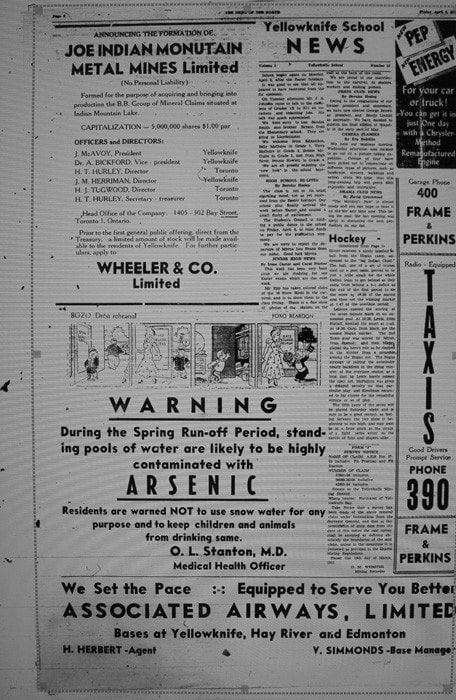As residents of Ndilo raise questions around recent reports from the N.W.T. Cumulative Impacts Monitoring Program showing higher arsenic levels found in lake sediment at swimming areas popular with the community’s children, EDGE thought it timely to republish this piece from September 2014 looking at a long-ago incident that resonates today:
By the end of the 1940s, gold mining operations began to spread large volumes of arsenic trioxide dust over Yellowknife and the surrounding area. A government report estimated that before pollution control equipment was installed, Con and Giant mines produced 22,000 pounds of arsenic trioxide per day from their roaster stacks.
But even after Con installed scrubbers in 1949, and Giant fitted an electrostatic precipitator as a filter in 1951, the mines still spewed 7,250 pounds per day of arsenic until technology upgrades reduced that to a more modest 695 pounds per day in 1959.
Arsenic trioxide dust accumulated, day after day, in snow through the long Yellowknife winters. Because arsenic is tasteless and odourless, many people would have had no idea that the snow and ice they melted or the water they collected was heavily contaminated with poison. There were warnings. In February 1949, the fledging Bevan Farm lost all of its milk cows after cutting a drinking hole for the herd in Kam Lake, a body of water that was contaminated because Con dumped arsenic slurry from its stack scrubbers in the adjacent Pud Lake.
Kay concluded that the people of Yellowknife had been subject to a kind of “human experiment” where the government measured the impacts of arsenic exposure in Yellowknife, “waiting to see what will happen to these people.”
Latham Island likely received more than its fair share of arsenic fallout, due to its location across Back Bay and downwind of prevailing breezes that frequently came from the direction of Giant Mine. Springtime represented a particularly dangerous time of year for the Latham Island community as a winter’s worth of arsenic dissolved into melted snow and seeped into local water bodies.
In April 1951, there were reports of widespread sickness, even death, on Latham Island due to arsenic poisoning. Some Yellowknives Dene remember that people suffered hair loss and skin lesions after bathing in the bay. But most tragically, a two-year-old Yellowknives Dene boy died from drinking contaminated water (at the request of his family members, we have withheld his name).
I.F. Kirkby, the Superintendent of Indian Affairs, doubted whether any arsenic contamination had occurred, due to unspecified precautions taken by the mining company. But a meeting between senior federal bureaucrats and officials from Con and Giant mines acknowledged that “Indians living on the north end of Latham Island used the water in the vicinity, with the result that a number of them had to be given hospital treatment and one died.”
The meeting minutes quote from a telegram sent by Dr. Oliver Stanton, the Medical Officer of Health, reporting the results of a coroner’s inquest on the young boy’s body: “Jury verdict, ‘died of acute gastroenteritis caused by arsenical poisoning administered by unknown means. Evidence indicated presence of arsenic in area of child’s home at time became ill.’ All snow has now melted. No pools or runoff water from now on. Lake water tests consistently low. I consider all danger past.”
If the acute risk had passed temporarily, as Stanton suggests, high levels of arsenic continued to pose a danger to people in the Yellowknife area in the early 1950s. In 1953, a memo described an “indigent Indian” named Henry Lafferty who suffered skin conditions and anemia due to arsenic poisoning. Yellowknives elders also recount how sled dogs and wildlife such as moose died suddenly after drinking water from the areas around the mines.
Despite the urgency of the situation, government officials waited until April 1951, to suggest that Stanton place ads in the local newspaper and post signs around local lakes warning of the danger.
The federal government was certainly aware there was a problem prior to the reports of illness. The Department of Resources and Development reported the high concentrations of arsenic in the snow on Latham Island in the winter of 1951. Despite the urgency of the situation, government officials waited until April 1951, to suggest that Stanton place ads in the local newspaper and post signs around local lakes warning of the danger.
The text was not translated into Weledeh or Dogrib, and there is no evidence of a door-to-door campaign to warn people who could not read English. Even if the warnings had been effective, the half-hearted information campaign neglected the fact that the Yellowknives did not have anywhere else to turn other than the local environment for essential supplies of drinking water.
Giant had committed to installing the electrostatic precipitator in 1950, but a rail strike and flooding around Winnipeg prevented delivery of the unit until May 1951. The company did not complete installation until October 1951, meaning that arsenic emissions continued unabated for six months after a child had been killed and large numbers of Yellowknives were sickened by arsenic.
The public information campaign continued, with two more ads in News of the North in July 1951. The government’s National Health and Welfare Department conducted a health study of all Yellowknifers under the leadership of Dr. Kingsley Kay, who recalled in a CBC interview 20 years later finding “skin conditions, cardiovascular effects, neuro pathology, you know loss of sensation, nerve sensation, that kind of thing.” Kay concluded that the people of Yellowknife had been subject to a kind of “human experiment” where the government measured the impacts of arsenic exposure in Yellowknife, “waiting to see what will happen to these people.”

In June 2013, members of the Yellowknives Dene First Nation, in collaboration with the Department of Aboriginal Affairs and Northern Development Canada, held the first of two healing ceremonies at the contaminated Giant Mine site. The roasting stack that spewed arsenic, since dismantled, is seen on the right | photo Laurie Sarkadi
Seepage of contaminated water from tailings ponds and other above surface arsenic sources also ensured that drinking water sources became contaminated. Water monitoring results in Back Bay from the 1950s and 1960s suggest frequent spikes above the 0.05 ppm safe level (a level five times greater than the current threshold of 0.01 ppm), with one report suggesting that contamination levels remained above safe levels 15 percent of the time. In 1969 the federal government moved the city water intake to the mouth of the Yellowknife River to bypass the pollution from Giant Mine. Measurements of local food sources, especially berries and local garden produce, contained arsenic levels ranging from 18 ppm to 2,228 ppm, well above the 1 ppm threshold adopted by the United States Public Health Service. Local health authorities simply warned people to wash local fruit and vegetables before eating.
More recent studies of large populations in South and Southeast Asia exposed to arsenic in well water suggest that even at low levels, arsenic exposure may cause skin conditions such as rashes, black spots (hyperpigmentation), thickening of skin (keratosis), or tingling sensations in the extremities (parenthsias). Arsenic exposure can impact brain, kidney and heart functions; skin, bladder, lung and liver cancers may develop over long periods of time.
In Yellowknife, reports and correspondence from the 1950s and 1970s document arsenic-related skin conditions among the general population, and especially among millworkers. Arsenic is also a carcinogen, but cancer rates in Yellowknife remain a bit of a mystery, as the frequent movement of people away from the region, the lag time it takes for the disease to develop, and the difficulty of isolating root causes make it very difficult to directly link cancer and arsenic exposures.
A Canadian Public Health Association report from the 1970s downplayed the risks from cancer, though the relationship between arsenic and the disease was not well understood at this time. Certainly Yellowknives Dene elders trace the outbreak of cancer in their community to pollution from the mine. Whether cancer rates increased or not, at least one story suggests that the long-term impacts of arsenic exposure could be lethal. According to a CBC interview with Yellowknives elder Michael Sikyea, the very old Elizabeth Drygeese died in 1974 with “arsenic in her body,” having complained about constant soreness in her lungs.
The Yellowknives Dene also raised specific concerns about access to drinking water in the 1970s. According to Sikyea, local health officials re-posted warning signs about using snow, ice, or Back Bay as sources of drinking water in 1975. Although Ndilo had not been hooked up to the City of Yellowknife water supply (even after the intake was moved upstream of the arsenic sources), by the 1970s clean water was being trucked to the village.
Remarkably, Ndilo residents were expected to pay for this water, even though a major gold mining operation and lax government regulation had combined to pollute a massive source of water that sits in the community’s backyard. Sikyea told the CBC that the five dollar per month charge was too much for many elders that lived on the edge of poverty, so many continued to haul snow, ice and water directly from the polluted bay.
Sikyea also wrote to Indian Affairs Minister Jean Chrétien in 1973, suggesting that Dr. Stanton had helped arrange for free delivery of water in the 1950s, but in the last few years Ndilo residents had been forced to pay. “Why should we pay others who poisoned our water,” Sikyea asked, “most of the people of the valley don’t get enough welfare to have food; we can’t pay $5 per month for water too. None of us have the money, and even if we did, we should not be forced to pay after all this trouble.”
The Yellowknife arsenic issue reached a national audience for the first time in the 1970s. There was heightened concern about pollution everywhere in North America, but the immediate spark for the renewed arsenic controversy was a comprehensive report that aired on CBC’s As it Happens in 1975.
The CBC suggested that a medical survey conducted by A.J. de Villiers of the federal Health and Welfare Biomedical Unit between 1966 and 1969 had been suppressed due to evidence of cancer and other ill health effects. Whatever the reason for the delay in making the report public, the federal government generally rebuffed increasingly angry requests from the CBC, the City of Yellowknife, and the National Indian Brotherhood for further information.
Health Minister Mark Lalonde downplayed the health and cancer risks in the de Villiers report, which was inconclusive on major health impacts, but ordered a precautionary health survey in 1975. When this study concluded that ill-health effects from arsenic were limited to a few millworkers, the National Indian Brotherhood joined forces with the United Steelworkers, and researchers at the University of Toronto to produce their own research on the issue.
Their analysis of hair samples from Aboriginal children and millworkers showed arsenic levels well above those taken from a control group in Whitehorse and what would be found under normal conditions elsewhere in Canada. To settle the issue, the federal government contracted the Canadian Public Health Association (CPHA) to conduct a comprehensive health and environmental survey and environmental impacts from arsenic.
In 1977 the CPHA reported once again that adverse health effects from arsenic were limited to millworkers who worked closely with arsenic dust. Although the Steelworkers and the NIB questioned the report, particularly its focus on short-term health impacts from arsenic rather than the long-term impacts of low dose exposures, local media declared the arsenic scare to be over. Additional dramatic reductions in emissions from the Giant Mine roaster stack — down to 29 lbs. per day by 1979 —added weight to the idea that Yellowknife no longer had an arsenic problem.
John Sandlos and Arn Keeling are two Memorial University academics commissioned by the Yellowknives Dene to delve into this dark chapter in Yellowknife’s history.

A News of the North ad from April 1951 was one of only a few arsenic warnings issued in YK.
The media, the town council and the silence surrounding arsenic poisoning of the ‘50s
by Jack Danylchuk
When newspapers indulge their egos, they boast of writing the first rough draft of history. Yellowknife in 1951 was a mining town of barely 3,000 people, with a radio station and a weekly newspaper, The News of the North, scribbling notes that have found their way into popular histories. But what gets left out of those chronicles sometimes says more about the times than what gets in.
Ted Horton, a former Edmonton Journal reporter, leased the newspaper – housed in a building that still stands in Old Town – from Duke DeCoursey, a publisher cut from the cloth of an era when editors wrote the stories, sold the ads, set up the pages and ran the press.
The paper concerned itself with the issues of the day. Governance of the territory and the spirited competition between hockey teams sponsored by the mines and the town dominated the front page, with the occasional snippet about life in even more remote villages. Its language revealed the prejudices of the era: Dene were Indians, Inuvialuit were Eskimo, shamans were witch doctors.
The News of the North paid particular attention to the workings of the council of appointed and elected trustees that administered the community’s affairs. The council oversaw all aspects of Yellowknife life, from oiling Franklin Avenue to suppress dust and setting booze prices in the Ingraham Hotel, to ordering closure of the Pioneer Theatre for faulty wiring and the location of the new post office.
History is a story told by the survivors and the records that survive flood and fire. The newspaper’s record for 1951 and council minutes share gaps, as if both engaged in self-censorship on events that would have been known to many.
There is nothing in council minutes from 1951 about arsenic contamination from the mines, or a warning, published in The News of the North, against drinking meltwater. The most arresting event of 1951, the death of a Dene child living on Latham Island from arsenic poisoning, passed without public comment by the newspaper or the council – as if the tragedy had occurred in a parallel universe. The story of the two-year-old’s death, however, lived on in the memories of Dene elders.
DeCoursey’s memoirs, his “Yellowknife Years” as he calls them, meander blindly past such historic events in a community ruled by mining companies, merchants and aviators. He makes no mention of arsenic poisoning millworkers at the mine, or killing Yellowknives Dene. Not a word.







